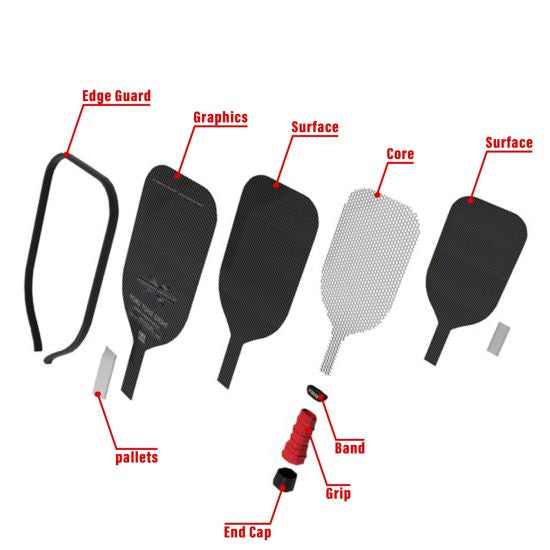When it comes to Pickleball, the paddle you choose can significantly impact your performance on the court. One crucial aspect to consider is the paddle surface material. Each material brings its own set of characteristics, affecting factors like power, control, and spin. Let's explore the key differences between various paddle surfaces to help you make an informed choice.
**Fiberglass:**
Fiberglass is a popular choice for players seeking a versatile and cost-effective option. Composed of woven glass fibers combined with epoxy resin, fiberglass-faced paddles offer a balanced blend of durability, control, and power. The smooth playing surface ensures consistent ball contact, making it an excellent choice for players looking for a reliable, all-around paddle without breaking the bank.
**UD Carbon Fiber:**
UD (Unidirectional) Carbon Fiber paddles take performance to the next level. These paddles are constructed using layers of carbon fibers aligned in a single direction. This results in enhanced stiffness and responsiveness, translating to impressive power on your shots. The unique structure of UD Carbon Fiber allows for a thinner paddle face, reducing wind resistance and providing an edge in quick, precision shots.
**3K Carbon Fiber:**
3K Carbon Fiber paddles are engineered using a distinctive weave pattern of 3,000 carbon fibers per tow. This design enhances strength and durability while maintaining a relatively lightweight feel. Players wielding 3K Carbon Fiber paddles experience improved control and maneuverability, making it an excellent choice for those who rely on finesse and touch in their gameplay.
**12K Carbon Fiber:**
Stepping up in fiber count, 12K Carbon Fiber paddles incorporate 12,000 carbon fibers per tow. This results in a more robust, high-density structure. The increased fiber density offers heightened power potential, making 12K Carbon Fiber paddles an ideal choice for players looking to dominate the court with authoritative shots.
**18K Carbon Fiber:**
For players who demand the absolute best in power and performance, 18K Carbon Fiber paddles are a top-tier choice. This material features an impressive 18,000 carbon fibers per tow, providing unparalleled strength and stiffness. The result? A paddle that delivers exceptional power without sacrificing control, giving players an edge in aggressive play styles.
**T700 Carbon Fiber:**
T700 Carbon Fiber is renowned for its exceptional balance between strength and flexibility. This material is highly regarded in the aerospace industry, and its application in pickleball paddles brings forth remarkable benefits. Paddles made from T700 Carbon Fiber offer a superb blend of power, precision, and maneuverability, making them a favorite among discerning players seeking top-tier performance.
**Toray T700 Carbon Fiber:**
Toray T700 Carbon Fiber is a grade above T700, known for its superior tensile strength and stiffness. Paddles crafted from Toray T700 Carbon Fiber exhibit unmatched power potential, enabling players to deliver authoritative shots with ease. This material is favored by competitive players looking for an extra edge on the court.
**T800 Carbon Fiber:**
At the pinnacle of carbon fiber technology, T800 Carbon Fiber sets the gold standard for strength and performance. Paddles utilizing T800 Carbon Fiber are incredibly rigid and lightweight, providing an unmatched combination of power, control, and responsiveness. Players wielding T800 Carbon Fiber paddles experience a level of play that's unparalleled, making them a top choice for serious competitors.
In conclusion, the choice of paddle surface material is a critical factor in determining your performance on the Pickleball court. Each material brings its own unique set of characteristics, allowing players to tailor their paddle to their specific playing style. Whether you value power, control, or a balance of both, understanding the nuances of these paddle surfaces empowers you to make an informed decision that enhances your gameplay. Choose wisely, and let your paddle be an extension of your skill and strategy on the court.

